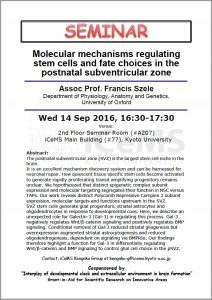iCeMS Kengaku Lab Seminar: Dr Francis Szele

The postnatal subventricular zone (SVZ) is the largest stem cell niche in the brain. It is an excellent mechanism discovery system and can be harnessed for neuronal repair. How quiescent tissue specific stem cells become activated to generate rapidly proliferating transit amplifying progenitors remains unclear. We hypothesized that distinct epigenetic complex subunit expression and molecular targeting segregates their function in NSC versus TAPs. Our work reveals distinct Polycomb Repressive Complex 2 subunit expression, molecular targets and functions upstream in the SVZ. SVZ stem cells generate glial progenitors, striatal astrocytes and oligodendrocytes in response to developmental cues. Here, we describe an unexpected role for Galectin-3 (Gal-3) in regulating this process. Gal-3 negatively regulates Wnt/β-catenin signaling and positively regulates BMP signaling. Conditional removal of Gal-3 reduced striatal gliogenesis but overexpression augmented striatal astrocytogenesis and reduced oligodendrogenesis, dependent on signaling via BMPRIα. Our findings therefore highlight a function for Gal-3 in differentially regulating Wnt/β-catenin and BMP signaling to control glial cell choice in the pSVZ.
- Lecturer
- Assoc Prof Francis Szele(Department of Physiology, Anatomy and Genetics, University of Oxford)
- Title
- Molecular mechanisms regulating stem cells and fate choices in the postnatal subventricular zone
- Date / Time
- September 14, 2016 / 16:30−17:30
- Venue
-
2nd floor Seminar Room (#A207), iCeMS Main Building (#77), Kyoto University
Directions
- Host
- Kyoto University Institute for Integrated Cell-Material Sciences (iCeMS) Mineko Kenagaku Lab
- Contact
- iCeMS Mineko Kengaku Lab | kengaku-g (at) icems.kyoto-u.ac.jp







